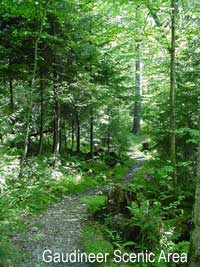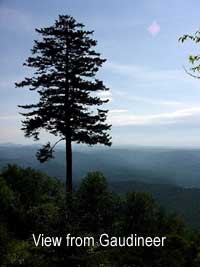|
GAUDINEER SCENIC AREA
This scenic area will be managed
to feature an undisturbed condition for study and enjoyment by
the public. Maintaining the natural appearance of the area is
essential.
Approximately 50 acres of the Gaudineer
Scenic Area is typical of, and considered part of, the virgin
red spruce type that originally occupied large portions of the
highland areas of West Virginia. The composition of this impressive
timber stand consists of virgin and second growth red spruce,
yellow birch, beech, red maple, sugar maple and other hardwood
species. Individual trees range up to 40 inches in diameter at
breast height and 300 years of age. The remaining 90 acres has
had some cutting, mainly salvage of blow-down, with most of the
original growth still standing. The total wood volume of the 140
acre tract is estimated at one and a half million board feet.
|

|
|
LOCATION
The 140 acre Gaudineer Scenic Area
is located near Gaudineer Knob of Shavers Mountain in Randolph
and Pocahontas Counties. The area is located about 5.5 miles from
Durbin, West Virginia. To reach the area travel west from Durbin
on US 250 for 4 miles to Forest Service Road 27, then north on
Forest Service Road 27 for 1.5 miles to the area. The Scenic Area
is in the headwaters of Glade Run and Old Road Run, tributaries
of Shavers Fork of Cheat River and West Fork of Greenbrier River,
respectively.
|

|
HISTORY
In October 1964 the Regional
Forester designated this area as a Scenic Area so that it
could be managed for its special values for public study,
use, and enjoyment. In May 1981 the Gaudineer Scenic Area
was designated a Registered Natural Landmark for its exceptional
value as an illustration of the Nation's natural heritage
and its contribution to a better understanding of man's
environment. In May 1983 the Scenic Area was registered
by the Society of American Foresters as an outstanding example
of a vegetative community in a near natural condition dedicated
for scientific and educational purposes.
|
PRESENT SITUATION
AND SAFETY
Management of this area to a near
natural stage and encouraging visitors to enjoy it presents a
safety concern. The abundance of dying mature red spruce and dying,
diseased American beech can be considered a natural stage in a
constantly changing environment. This, however, increases the
chances of visitors being injured by falling limbs or trees. For
safety reasons, avoid using the area when the wind is blowing
the tree tops.
For more information contact the
Greenbrier Ranger District at (304) 456-3335.
|

